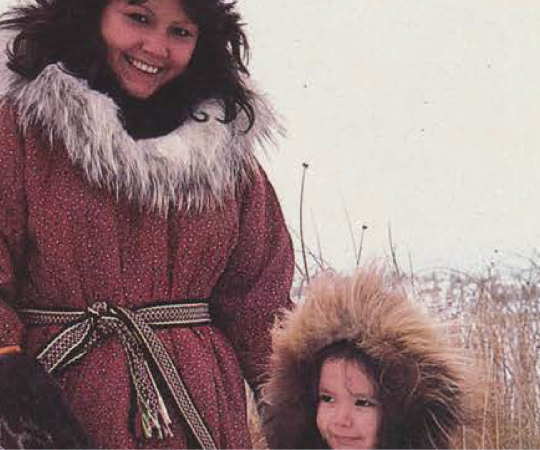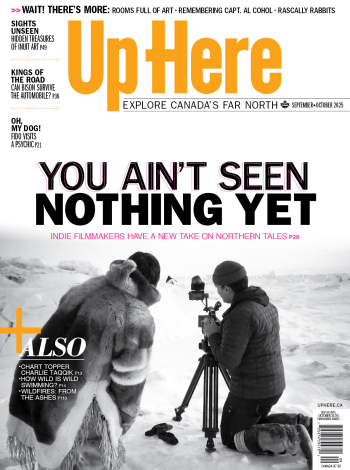It was too early in the year to be picking ivigak along the shore at Coats Bay. This was still winter in 1996, and on the Belcher Islands the yellow Arctic lyme grass works best when it’s gathered in the spring. But the women, around 20 of them from Sanikiluaq, had the time to gather grass. An air shipment of commercial sewing machines—meant for sewing eiderdown parkas through a Nunavut Arctic College contract—had been held up, and all the mechanisms were frozen solid. The sewing machines had to be taken apart to avoid rust.
One of the women, Sarah Appaqaq, suggested they use their time to take up basket making. Grass basket sewing was a tradition of the coastal Hudson Bay community where ivigak grows well, but the craft had fallen out of favour when carvings were pushed as a more lucrative craft to sell in southern markets.
And so they picked grass in January, and dried it in large swaths on the floor at the community learning centre. Sitting where they’d planned to sew the duck-down parkas (winter garments made in the Arctic by Inuit that most of the sewers found weren’t actually useful in the North) these women instead revived basket sewing on the Belcher Islands.
“No one said they remembered,” Margaret Lawrence recalls from her kitchen table in Iqaluit, where she’s set up to sew a basket. She knots a blade of dried ivigak to start the basket’s centre coil. As a long-time Sanikiluaq teacher and course facilitator of the stalled college sewing program, Lawrence, 68, learned to sew grass baskets along with the other women.
“It was a strong process of communication,” says Lawrence, who was born in Japan and moved to Sanikiluaq in 1988. Dubbed by the women as their project documenter, last year she penned an instructional book on basket making, Our Hands Remember: Recovering Sanikiluaq Basket Sewing.

Caroline Meeko, an elder who hadn’t been able to carve due to poor eyesight, had been one of the last women to regularly make baskets in Sanikiluaq. Her daughter Annie brought the group a Polaroid of those baskets and shared what fragments of the skill she could. The women knew already how to sew with ivigak, which works for insulating kamiks, or making fish mats.
Skilled seamstresses and carvers, they picked up the art form fairly quickly. “Their pre-existing skills meant a lot,” Lawrence says. Those first baskets took about five weeks to finish, and they were a long way off from the tightly sewn bowls the practiced artisans now sew years later. Still, all the baskets sold at a trade show in Iqaluit, and people asked for more. The women realized the revived skill held an economic potential that it hadn’t for their mothers when, in the ’50s and ’60s, a basket might have sold for only five dollars. Today, a mid-sized ivigak basket might easily sell for $1,200—that’s with a soapstone carving inside.
Using a flat-ended needle called a sharp, Lawrence shreds a blade of dried grass lengthwise three times. The flattened blade keeps the grass from ripping. “You really have to feel good about your needle,” says Lawrence. When it’s not in use, she pins the tool to her blouse for safekeeping. For a smaller basket, she’d split the grass into four threads. The women learned to split their blades of ivigak like this to sew tighter basket coils.
A sea grass, ivigak grows well in the Belcher Islands, where even the fog is heavy with salt. In more northern Nunavut communities, where the cold stunts its growth, ivigak isn’t useful for sewing baskets. Once dried it will keep for a few years. To prep the grass for sewing, bundles are soaked in cold water for just under an hour (not too long or it will begin to rot). The damp grass is wrapped in a tea towel and then frozen to temper the blades.
The “inside grass”—older or discoloured blades—is used to fill the coils. The strongest grass, gathered while it’s still full on yellow or tan, is bundled as “outside grass,” the part that you see as the outer coil. Harvested one blade at a time, and at a length of 10 inches or more, ivigak is picked at its base with the forefinger and thumb—snapped, never pulled—and always with bare hands. “You’re not pulling up the whole plant, you’re not disturbing the roots of the plant,” she says.

Lawrence threads her stripped grass through the centre of the knot she’s made in a full stand of “inside” ivigak, and starts to wrap the thread around that knob, one stitch at a time. That work is easier when you’ve built up kaut, or callouses. “Gradually this little knot, it gets covered,” and starts to look like a snail shell, Lawrence says. “The hand that holds the coil controls the curve.” A basket the size of an apple might take 15 to 25 hours to sew. “It is a slow process, I can understand why Tupperware took over the world.”
The college sewing project ended in 1999, but women in Sanikiluaq have gone on to build a name for Belcher Island's baskets. You can find their work in a permanent display at the Legislative Assembly of Nunavut and at the Iqaluit campus of the Nunavut Arctic College. Sarah Appaqaq, who suggested basket making in the first place, is now known for her star patterns and use of brightly coloured synthetic sinew. In Alaska, designs are sewn into ivigak baskets using dyed sinew from sea-mammals. In Nunavik, women might use fabric and threads to sew patterns, while Nunatsiavut baskets are known for their scalloped edges and wavy patterns. Women in the Belcher Islands traditionally use strips of qisiq—dehaired seal pelt—to sew dark patterns into the yellow baskets. “You incorporate it as you work the basket, so when you look inside the basket there are no loose ends,” Lawrence says. Some women began to sew baskets from grass dyed with berries while other baskets have carved handles sewn on top.
Lawrence embellished one of her basket covers, pictured in her book, with short strips of qisiq sticking up and pearl beads to make the handle look like a sea urchin, a Sanikiluaq delicacy. Not wanting to benefit financially from an Inuit art form she learned with her friends, Lawrence always gifts her baskets. Fitting, as ivigak baskets have always been part of an honouring system for Inuit. “If you were lucky you were given one,” Lawrence says. Ivigak baskets were and continue to be inherited from elder namesakes and are treasured as holders of smaller valuables easily lost.










